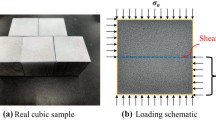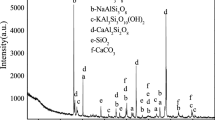Abstract
Time is one of the often-neglected factors in the assessment of the erratic failure of shale rock. Laboratory-creep experiments showed that constant stress induces time-dependent failure in brittle shale. However, the microscopic reason for time-dependent deformation in shale is still unknown. In the current study, triaxial creep and recovery experiments showed that the brittle shale specimens exhibit viscoelastic and viscoplastic creep deformation at constant stress state. In addition, the X-ray computed tomography scan of Marcellus shale showed that the shale specimens contained significant volume of preexisting microcracks. The statistical correlation among permanent strain during the triaxial experiment and stress-induced change in the three-dimensional geometry of microcracks showed that the microcracking is the microscopic reason for viscoplastic creep deformation in shale. In addition to the time and level of constant differential stress, factors such as orientation of bedding planes and specimen heterogeneity also influence the nature of creep deformation.




















Similar content being viewed by others
References
Arena A, Piane CD, Sarout J (2014) A new computational approach to cracks quantification from 2D image analysis: application to micro-cracks description in rocks. Comput Geosci 66:106–120
Arganda-Carreras I, Kaynig V, Rueden C, Eliceiri KW, Schindelin J, Cardona A, Seung HS (2017) Trainable Weka segmentation: a machine learning tool for microscopy pixel classification. Bioinformatics 33(15):2424–2426
Aristorenas GV (1992) Time-dependent behavior of tunnels excavated in shale. Ph.D. Dissertation, Department of Civil Engineering, MIT
ASTM (2014) Standard test methods for compressive strength and elastic modulii of intact rock core specimens under varying state of stress and temperatures. ASTM International, West Conshohocken
Atkinson BK (1979) A fracture mechanics study of subcritical tensile cracking of quartz in wet environments. Pure appl Geophys 117:1011–1024
Atkinson BK (1984) Subcritical crack growth in geologic materials. J Geophys Res 89(B6):4077–4114
Baud P, Meredith PG (1997) Damage accumulation during triaxial creep of Darley Dale sandstone from pore volumometry and acoustic emission. Int J Rock Mech Min Sci 34(3–4):24.E1–24.E10
Brace WF, Paulding BW Jr, Scholz C (1966) Dilatancy in the fracture of crystalline rocks. J Geophys Res 71(16):3939–3953
Brown JW (1965) An investigation of microseismic activity in rock under tension. M.S. Thesis, Pennsylvania State University
Cristescu ND, Hunsche U (1998) Time effects in rock mechanics. Wiley, Hoboken
Duan K, Kwok CY (2016) Evolution of stress-induced borehole breakout in inherently anisotropic rock: insights from discrete element modeling. J Geophys Res Solid Earth 121:2361–2381
Dubey RK, Gairola VK (2000) Influence of structural anisotropy on uniaxial compressive strength of pre-fatigued rocksalt from Himachal Pradesh, India. Int J Rock Mech Min Sci 37(6):993–999
Evans RH (1936) The elasticity and plasticity of rocks and artifical stones. Proc Leeds Philos Lit Soc 3(3):145–158
Griggs D (1939) Creep of rocks. J Geol 47(3):225–251
Guo S et al (2017) Numerical studies on the failure process of heterogenous brittle rocks or rock-like materials under uniaxial compression. Materials 10(4):378
Gupta N (2019) Fundamental mechanism of time dependent failure in shale. Graduate Theses, Dissertations, West Virginia University. https://researchrepository.wvu.edu/etd/7445
Gupta N, Mishra B (2017) Creep characterization of Marcellus shale. In: 51st U.S. Rock Mechanics Symposium. San Fransisco, CA
Haimson BC (1978) Effect of cyclic loading on rock. In: Dynamic geotechnical testing, pp 228–245
Heap MJ (2009) Creep: time-dependent brittle deformation in rocks. Ph.D. Dissertation, University College London
Hobbs DW (1970) Stress–strain–time behavior of a number of coal measure rocks. Int J Rock Mech Min Sci 7:149–170
Hu B et al (2019) Cyclic loading–unloading creep behavior of composite layered specimens. Acta Geophys 67:449–464
Illston JM (1978) Creep of concrete. In: Pomeroy CD (ed) Creep of engineering materials. Heffers Printers Ltd, Cambridge, pp 47–66
Khosravi E (2017) An experimental investigaton on creep behavior of shale rocks: with emphasis on the influence of temperature and anisotropy. Masters Dissertation, University of Oklahoma
Kim YR, Guddati MN, Underwood BS, Yun TY, Subramanian V, Savadatti S (2009) Development of a multiaxial viscoelastoplastic continuum damage model for asphalt mixtures. U.S. Department of Transportation
Kranz RL (1979) Crack growth and development during creep of Barre granite. Int J Rock Mech Min Sci Geomech Abstr 16:23–35
Li Y, Ghassemi A (2012) Creep behavior of Barnett, Haynesville and Marcellus shale. In: 46th U.S. Rock Mechanics/Geomechanics Symposium. American Rock Mechanics Association, Chicago, p 7
Li Z, Nguyen TS, Su G, Labrie D, Barnichon JD (2017) Development of a viscoelastoplastic model for a bedded argillaceous rock from laboratory triaxial tests. Can Geotech J 54:359–372
Maerz N (1990) Photoanalysis of rock fabric. Ph.D. Thesis, University of Waterloo, Canada
Matsushima S (1960) Variation of the elastic wave velocities of rocks in the process of deformation and fracture under high pressure. Bull. Disaster Prevention Research Institute, Kyoto University, 32, pp 1–8
Michalske TA, Freiman SW (1982) A molecular interpretation of stress corrosion in silica. Nature 295:511–512
Mishra B, Verma P (2015) Uniaxial and triaxial single and multistage creep tests on coal-measure shale rocks. Int J Coal Geol 137(1):55–65
Mogi K (1962) Study of the elastic shocks caused by the fracture of a heterogenous material and its relation to earthquake phenomena. Bull Earth Res Inst (Tokyo) 40:125
Nevin CM (1957) Principles of structural geology, F. edn. Wiley, New York
Niandou et al (1997) Laboratory investigation of the mechanical behavior of Tournemire shale. Int J Rock Mech Min Sci 34(1):3–16
Nishihara M (1952) Creep of shale and sandy shale. J Geol Soc Jpn 58:373–377
Ohnaka M (1983) Acoustic emission during creep of brittle rock. Int J Rock Mech Min Sci Geomech Abstr 20:121–134
Peng J, Wong LNY, Teh CI (2017) Influence of grain size heterogeneity on strength and microcracking behavior of crystalline rocks. J Geophys Res Solid Earth 122:1054–1073
Phillips DW (1931) Further investigation of the physical properties of coal measure rocks and experimental work on development of fractures. Trans Inst Min Eng 82:432–449
Price NJ (1964) A study of the time-strain behavior of coal measure rocks. Int J Rock Mech Min Sci 1:277–303
Reid TR, Harrison JP (2000) A semi-automated methodology for discontinuity trace detection in digital images of rock mass exposures. Int J Rock Mech Min Sci 37:1073–1089
Rinehart JS (1965) Dynamic fracture strength of rocks. In: Proceedings of the seventh US Rock Mechanics Symposium, pp 205–208
Robertson EC (1960) Creep in Solenhofen limestone. Geol Soc Am Mem 79:227
Rouabhi A, Tijani M, Rejeb A (2007) Triaxial behavior of transversely isotropic materials: application to sedimentary rocks. Int J Numer Anal Methods Geomech 31:1517–1535
Roylance D (2001) Stress–strain curves. Retrieved from http://web.mit.edu/course/3/3.11/www/modules/ss.pdf
Scholz CH (1968) Microfracturing and the inelastic deformation of rock in compression. J Geophys Res 73(4):1417–1432
Senseny PE (1983) Review of constitutive laws used to describe the creep of salt. Office of Nuclear Waste Isolation, Batelle Memorial Institute, Report ONWI-295
Senseny PE, Hansen FD, Russell JE, Carter NL, Handin JW (1992) Mechanical behaviour of rock salt: phenomenology and micromechanisms. Int J Rock Mech Min Sci Geomech Abstr 29(4):363–378
Singh DP (1975) A study of creep of rocks. Int J Rock Mech Min Sci Geomech Abstr 12:271–276
Sone H (2012) Mechanical properties of shale gas reservoir rocks and its relation to the in situ stress variation observed in shale gas reservoirs. Ph.D. Dissertation, Department of Geophysics, Stanford University
Sone H, Zoback MD (2011) Visco-plastic properties of shale gas reservoir rocks. In: 45th U.S. Rock Mechanics/Geomechanics Symposium. American Rock Mechanics Association, San Francisco, p 7
Sonka M, Hlavac V, Boyle R (1999) Image processing, analysis, and machine vision. PWS Publishing, Pacific Grove
Taheri A, Hamzah N, Dai Q (2017) Degradation and improvement of mechanical properties of rock under triaxial compressive cyclic loading. Jpn Geotech Soc Spec Publ 5(2):71–78
Watanabe H (1963) The occurence of elastic shocks during destruction of rocks and its relation to the sequence of earthquakes. Geophysical papers dedicated to Professor Kenso Sassa, pp 653–658
Wu C et al (2016) Biaxial creep test study on the infuence of structural anisotropy on rheological behavior of hard rock. J Mater Civ Eng 28(10):4
Zhang C-L et al (2019) Investigation on anisotropy of mechanical properties of Callovo-Oxfordian claystone. Eng Geol 251:128–145
Zhang C-L (2018) Thermo-hydro-mechanical behavior of clay rock for deep disposal of high-level radioactive waste. J Rock Mech Geotech Eng 10:992–1008
Zhang QB, Zhao J (2014) A review of dynamic experimental techniques and mechanical behaviour of rock materials. Rock Mech Rock Eng 47:1411–1478
Zuidervald K (1994) Contrast limited adaptive histogram equalization. In: Heckbert PS (ed) Graphic Gems IV. Academic Press Professional, Inc., San Deigo, pp 474–485
Acknowledgements
Financial support for this work was provided by the Centers for Disease Control and Prevention-National Institute of Occupational Health and Safety (No. 200-2016-92214). The authors would also like to thank Dustin Crandall, Sarah Brown, Johnathan E. Moore, and Bryan Tennant at National Energy Technology Laboratory in Morgantown, WV for X-ray CT Scan of shale specimen. The authors would also like to thank Dr. Karen Martin and Sarah McLaughlin from Animal Models and Imaging Facility (AMIF) of West Virginia University (WVU) to provide the access to Bruker CTAn software.
Author information
Authors and Affiliations
Corresponding author
Ethics declarations
Conflict of interest
The authors declare that they have no conflict of interest.
Additional information
Publisher's Note
Springer Nature remains neutral with regard to jurisdictional claims in published maps and institutional affiliations.
Rights and permissions
About this article
Cite this article
Gupta, N., Mishra, B. Influence of stress-induced microcracks on viscoplastic creep deformation in Marcellus shale. Acta Geotech. 16, 1575–1595 (2021). https://doi.org/10.1007/s11440-020-01108-2
Received:
Accepted:
Published:
Issue Date:
DOI: https://doi.org/10.1007/s11440-020-01108-2




